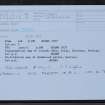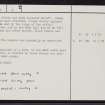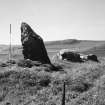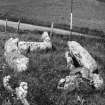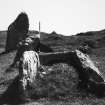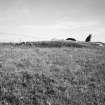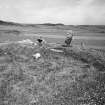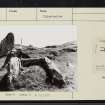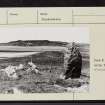Islay, Cragabus
Chambered Cairn (Neolithic)
Site Name Islay, Cragabus
Classification Chambered Cairn (Neolithic)
Canmore ID 37609
Site Number NR34NW 6
NGR NR 32923 45188
Datum OSGB36 - NGR
Permalink http://canmore.org.uk/site/37609
- Council Argyll And Bute
- Parish Kildalton And Oa
- Former Region Strathclyde
- Former District Argyll And Bute
- Former County Argyll
NR34NW 6 3292 4518.
(NR 3291 4518) Creag Mhor (NR)
OS 6" map, Argyllshire, 2nd ed., (1900)
The ruined chamber of a Clyde group chambered cairn lies on the west side of Creag Mhor, a small hill of rock outcrop. The site is grass covered and there is no sign of any cairn material. The conspicuous standing stone about 10ft east of the chamber is now 7ft high; comparison with this and other measurements made by Bryce (1901) shows that there has been a considerable rise in ground level since 1901. The stone should probably be regarded as the survivor of a pair of portals, which would mean that the chamber was originally about 26ft long, with 4 or 5 compartments; the existing chamber in 16 1/4ft long and 3 1/4ft to 3 1/2ft wide, the slabs projecting about 1ft. When excavated by Bryce the compartments were found to be "filled with stones and dark coloured mould". Human bones were "in much disorder, though mostly grouped in the corners, and by the sides of the cists." Artifacts found, now in the NMAS (all Acc. No. EO 255) included beaker and other sherds, flint flakes and pebbles.
T H Bryce 1902; A S Henshall 1972, visited 1962.
NR 3292 4518 The remains are generally as described and planned.
The false impression of a kerb, to the west south west of the chambers, is crested by large stones set into a late field bank scarp.
Surveyed at 1:10000.
Visited by OS (JRL) 10 June 1978.
Field Visit (May 1980)
NR 329 451. The chamber and part of the facade comprise virtually all that now remains of this chambered cairn, which is situated 60m SW of Lower Cragabus at the NW end of a rocky knoll known as Creag Mhor. The public road passes immediately to the N, while to the S there is a disused track which served the quarry that has destroyed much of the knoll. The cairn itself has been almost entirely removed, but it was probably aligned E and W with the chamber at its E end. Excavations were carried out on the site in 1901, and the present account incorporates information from the published report (Bryce 1902).
Several stones of the facade survive, but, as may be seen from the plan (RCAHMS 1984), not all of them remain in situ. The most northerly stone of the facade is an impressive block still exposed to a height of 1.8m; excavation, however, showed that its overall height was 3.5m. On the line of the entrance to the chamber there is a second stone now protruding some 0.13m and measuring about 0.35m by 0.07m. The adjacent upright to the S appears to have fallen forward slightly and only just protrudes above the grass, measuring 0.6m by 0.15m. The final (s) stone on the line of the facade has fallen and is about 2.1m long, at least 0.4m broad and 0.3m thick. A further boulder, not in situ, lies beside the track.
The chamber measures 4.8m in length and about 1m in width and depth internally and was formerly divided by transverse slabs into at least three compartments. The central and W transverse slabs are missing, but the other two stones stand to approximately the same height as the sides of the chambers. The stones of the E and central compartments overlap, but the S side-slab of the W compartment merely butts against its neighbour.
The site had already been plundered before the excavation took place, but a large number of disarticulated human bones were found grouped in the corners and at the sides of the compartments. In the central section of the chamber there were sherds of Beaker pottery and animal bones, including those of an ox and a pig or sheep; a number of flint flakes and cores and some burnt bones, not certainly human were also recovered. The pottery and flints are now in the National Museum of Antiquities of Scotland.
RCAHMS 1984, visited May 1980
Measured Survey (May 1980)
RCAHMS surveyed this chambered cairn with plane-table and alidade at a scale of 1:100. The resultant plan was redrawn in ink and published at the reduced scale of 1:250 (RCAHMS 1984, fig. 49A).





















